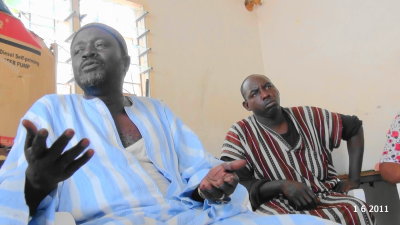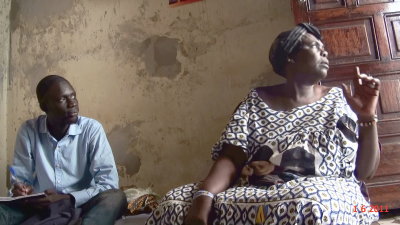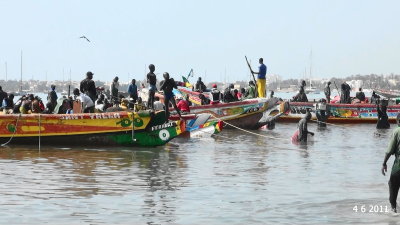Report of the visit to wholesalers and fishmongers in Hann
 We went to the beach in Hann (Yarakh in Woloff) on Wednesday, 01/06/2011, to meet the various actors in the fisheries in Senegal. The first step was meeting with wholesalers who received us at the offices at the landing place in Hann. The session began with self-presentations by the participants, including people living in Hann and the delegation of Mundus maris / Mare Nostrum led by Carla, who was assisted and Stefan and, for the occasion, by Oumar Sow, a member of the local MM team. Following this presentation, Carla, in her capacity as coordinator of Mare Nostrum, opened the discussion by asking questions relating to key challenges the people active in the fishery face and the solutions they recommend. Babacar Mbaye, called "Mbaye Rokh," representing the range of wholesalers Hann, explained the main constraints to the development of their activities, supported in this by his fellow wholesalers. They first defined the activity of fish traders as that of purchasing seafood directly from fishermen to sell the fish either to companies that process or export it to overseas or to women fish vendors there or in the villages.
We went to the beach in Hann (Yarakh in Woloff) on Wednesday, 01/06/2011, to meet the various actors in the fisheries in Senegal. The first step was meeting with wholesalers who received us at the offices at the landing place in Hann. The session began with self-presentations by the participants, including people living in Hann and the delegation of Mundus maris / Mare Nostrum led by Carla, who was assisted and Stefan and, for the occasion, by Oumar Sow, a member of the local MM team. Following this presentation, Carla, in her capacity as coordinator of Mare Nostrum, opened the discussion by asking questions relating to key challenges the people active in the fishery face and the solutions they recommend. Babacar Mbaye, called "Mbaye Rokh," representing the range of wholesalers Hann, explained the main constraints to the development of their activities, supported in this by his fellow wholesalers. They first defined the activity of fish traders as that of purchasing seafood directly from fishermen to sell the fish either to companies that process or export it to overseas or to women fish vendors there or in the villages.
 The oldest among the fishmongers present at the meeting attested to the good health of their business in the past despite the modest and very basic traditional working means available to them. They said they did not need ice to preserve fish because it was selling fast and they it put on carts to sell in the neighborhoods. The current situation is alarming, they say, and a united reaction by the real actors of the fishery is needed. Among the difficulties that Mr. Mbaye Rokh mentioned, we note:
The oldest among the fishmongers present at the meeting attested to the good health of their business in the past despite the modest and very basic traditional working means available to them. They said they did not need ice to preserve fish because it was selling fast and they it put on carts to sell in the neighborhoods. The current situation is alarming, they say, and a united reaction by the real actors of the fishery is needed. Among the difficulties that Mr. Mbaye Rokh mentioned, we note:
-
An inability to meet the administrative requirements imposed by banks: the guarantees to be produced for the acquisition of funds from lending institutions are very heavy and therefore the fish vendors often lack the means to start or to continue their activities;
-
 Enormous difficulties to equip themselves with appropriate trucks that could be related to the current policy of the Senegalese authorities, resulting in:
Enormous difficulties to equip themselves with appropriate trucks that could be related to the current policy of the Senegalese authorities, resulting in:-
Lack of administrative measures to cushion the exorbitant cost of these refrigerated trucks and their poor quality;
-
The legislative ban on cars allowed to enter Senegal, a restriction which is at the same time an obstacle to the acquisition of certain quality vehicles.
-
-
A lack of vision and lack of willingness on the part of public authorities to provide a solution to the old problem of the preservation of products: the fishmongers and especially the women fish mongers denounced in fact a great need in cold rooms to ensure conservation of their products. Without a solution to the problem of conservation, fish traders continue to depend on the supply of ice at a high price that can climb up to 3000 FCFA or even 4000 FCFA per kilo;
-
Unfair competition they face from foreign wholesalers (Burkina Faso, Mali), who benefit from support by their governments and from the area of free movement of goods and people instituted by ECOWAS.
And they denounce the silence, the laxism and inertia of state authorities to deal with their difficulties and propose all the same some solutions so that the actors in the fisheries can enjoy the fruit of their work and that fishing becomes more transparent and is sustainable.
 We then made for the women fish vendors and were received by the ladies Fatou Diop NIANG and Khady FALL, called "Sela", both officials and representatives in Hann, Senegal (National Collective of Artisanal Fishermen in Senegal: CNPS). They gave us an idea of how their activities of selling and trading fish, too, are not always rewarded for their efforts, because they have difficulties with the acquisition and distribution of fish. They started with acknowledging the fishermen who, they say, are the bravest players in the fishery and in spite of that suffer more than any other.
We then made for the women fish vendors and were received by the ladies Fatou Diop NIANG and Khady FALL, called "Sela", both officials and representatives in Hann, Senegal (National Collective of Artisanal Fishermen in Senegal: CNPS). They gave us an idea of how their activities of selling and trading fish, too, are not always rewarded for their efforts, because they have difficulties with the acquisition and distribution of fish. They started with acknowledging the fishermen who, they say, are the bravest players in the fishery and in spite of that suffer more than any other.
 Women fish traders have denounced the scarcity of resources. Depending exclusively on the sale of fish as a source of income, fishmongers consider the scarcity of resources is the biggest worry hanging over them. Another concern relates to the fact of the character of Hann as a traditional fishing village. This tends to disappear because most young people are no more attracted to this activity which is not rewarding to the practitioners, they suffer more than they earn. The acquisition of funds to support them and spare them the risk of cessation of activity is also a problem of these women, who often are not educated enough to take the appropriate counter measures.
Women fish traders have denounced the scarcity of resources. Depending exclusively on the sale of fish as a source of income, fishmongers consider the scarcity of resources is the biggest worry hanging over them. Another concern relates to the fact of the character of Hann as a traditional fishing village. This tends to disappear because most young people are no more attracted to this activity which is not rewarding to the practitioners, they suffer more than they earn. The acquisition of funds to support them and spare them the risk of cessation of activity is also a problem of these women, who often are not educated enough to take the appropriate counter measures.
 They claim to have charges greater than those of wholesalers because they also have to buy ice to keep their fish and they must pay more for young men so that their products reach the sales sites.
They claim to have charges greater than those of wholesalers because they also have to buy ice to keep their fish and they must pay more for young men so that their products reach the sales sites.
They also denounce the fact that only the fishermen talk of the problems of fishing, while others are in their offices owning sea-going canoes remain unresponsive, while it is they who earn more than fishers and do not suffer.
After recalling that they were the main breadwinners of their families, the women have developed solutions and ideas to restore the former luster of fishing and preserve the cultural identity of Hann.
 Faced with these difficulties, before adjourning the meeting and to provide alternatives, the women fishmongers issued a vow to the Mundus maris mission to work together in the coming years to explore the perspectives provided by:
Faced with these difficulties, before adjourning the meeting and to provide alternatives, the women fishmongers issued a vow to the Mundus maris mission to work together in the coming years to explore the perspectives provided by:
-
The establishment of marketing cooperatives or other type of organisation adapted locally to improve working conditions and lives of these women culturally but also economically dependent on fishing;
-
Prospecting work in Europe sought by the wholesalers and especially women fishmongers for which they hope to get the help of the delegation of Mundus maris to help them identify alternative solutions to the conservation of fishery products, given that Mundus maris is not involved in large investment projects;
-
 The idea of implementing a pilot project towards the creation of a social security fund for fishermen so that they can still be supported when they are no longer able to carry out their activities (illness or retirement); in the first place, the initiative should target women.
The idea of implementing a pilot project towards the creation of a social security fund for fishermen so that they can still be supported when they are no longer able to carry out their activities (illness or retirement); in the first place, the initiative should target women.
Click here to see a slide on the Mundus maris channel show about the ground realities in Yoff and Hann.
Click here to see a slide show video on the Mundus maris channel about the activities of Fatou and Sela as fish mongers in Hann.
All photos by Stefan Karkow.








































